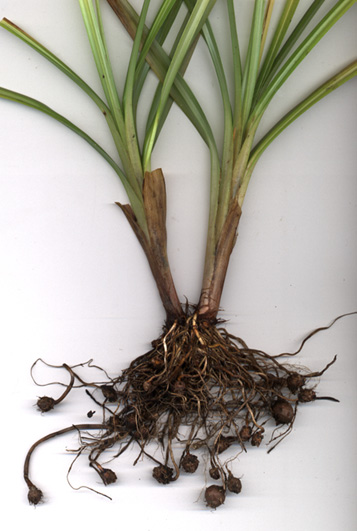| Recently I confirmed that nut-sedge does exist wild in the Seattle area. Though it spreads and increases by making tubers (called nuts), it simply does not flower or reseed here. Presumably it is not getting the heat units it needs. Over the years, there are five other species of Cyperus that have been found wild and making flowers and seeds in the Seattle area (listed below at the end); and cultivated non-wild cousins also can make seeds here. Somehow, I had overlooked the nut-sedge, even though it has grown in this area for decades, and I had hoped that it was here. Now, with this article, I make amends. |
| It is a grass-like plant known world-wide; of both positive and negative economic impact. Optimist that I am, let us begin with the good news. Cyperus esculentus has a vast worldwide range, and a variant of it was harvested --if not cultivated-- in Egypt as early as 2,400 B.C. Cyperus is an ancient Greek name; the epithet esculentus, applied by Linnaeus in 1753, refers to the edibility of the plant. |
Depending on whether a taxonomist splits or lumps, the genus Cyperus has some 300 to 600 species. They thrive in wet areas, mostly in warm or tropical regions. Relatively few species are of economic importance; five main ones are:
|
| C. alternifolius hort. Umbrella Plant |
| C. esculentus L. Yellow Nut-sedge; Chufa |
| C. longus L. Sweet Galingale |
| C. Papyrus L. the Egyptian Paper Plant |
C. rotundus L. Purple or Red Nut-sedge; Coco Grass
|
| As for our present subject, C. esculentus, a distinction must be made between its wild manifestations and cultivated version. The latter has been named var. sativus Boeckl., is Old World, and has various cultivars. The plant is densely tufted, with crowded and larger tubers, and it rarely flowers. Its tubers are more gray-orange than gray-brown, and have a higher oil and sugar content. The plant is not as cold-tolerant. It has been called Chufa (a Spanish name?), Earth Almond, Tiger Nut, Rush Nut, Zulu Nut, and Nut Grass. |
| In Washington State, the northern U.S. and in Canada our wild version is var. leptostachyus Boeckl., and I think that the one I found in Seattle, and have reproduced for you, is this kind. The Seattle specimens make leaves that are in whorls of three, are hairless, glossy, with smooth rather than sharp margins, and are no wider than three-eighths of an inch. The tubers are no larger than half an inch. |
| In the Old World, the tubers are cultivated, they are eaten raw or mashed into drinks (horchata de chufa) or made into flour, or an oil is extracted. The tender young leaf bases have been eaten in salads. The tubers are 4% protein, 24% fat, 30% starch, 16% sucrose. |
| In the U.S., nut-sedge has been cultivated, but mainly as hog food, and is regarded as a weed by most people. The Washington State noxious weed officials had listed it for years, until Peter Zika told them to cease and desist, because it is a Washington native plant, and the State weed law, rightly or wrongly, defines noxious weeds as non-native species only. |
| The plant is extending its original native range of riversides and lakesides. It is harmful to some crops. It is very difficult to destroy when it infests fields or gardens. As with horsetail (Equisetum arvense), it easily pops up through asphalt roads. But it is native, so the weed officials are stuck. I ate a tuber and found it crunchy, mildly sweet like a hazel or almond, and the fibrous skin was chewy. If a person wants to grow this as an edible crop, I suggest using a container, the way some people grow potatoes in garbage cans. |
| It is worth noting that a relative, C. rotundus, the Purple or Red Nut-sedge or Coco Grass, also bears tubers. It is routinely ranked as the world's absolutely worst weed. But this species is more cold-tender, its tubers are aromatic and taste bitter, its leaves are more slender, its seeds darker, and it has far more significance in medicinal applications than as a food. It has not been found in Washington State, though it is worthy of being cultivated at the University of Washington Medicinal Herb Garden. It is an active tranquilizer and blood pressure lowering herb. It has been used for arthritis, conjunctivitis, a remedy for liver damage, and as an aid to weight loss. |
The five other Cyperus species noted wild in the Seattle area, as reported in my book Wild Plants of Greater Seattle:
|
| C. bipartitus (=C. rivularis) Shining Flatsedge or Cyperus --Small annual; extant but rare; noted only at Lake Sammamish State Park. |
| C. Eragrostis (=C. glaber hort.) Stargrass. Pale Galingale --Perennial from S America; cultivated sparingly as an ornamental; naturalized weedily. |
| C. erythrorhizos Redroot Flatsedge --Small annual; extant, noted only on Duwamish River tideflats. |
| C. odoratus (=Torulinium odoratum) Coarse or Fragrant Galingale or Flatsedge --Annual from C & S America; naturalized at one wet sunny site since 1997 or 1998. |
C. Schweinitzii Schweinitz's Flatsedge. Rough Sand-Sedge --N American perennial of sandy soil; a waif collected on Seattle's Harbor Island in 1954.
Back
|

Cyperus esculentus scan by ALJ
|

